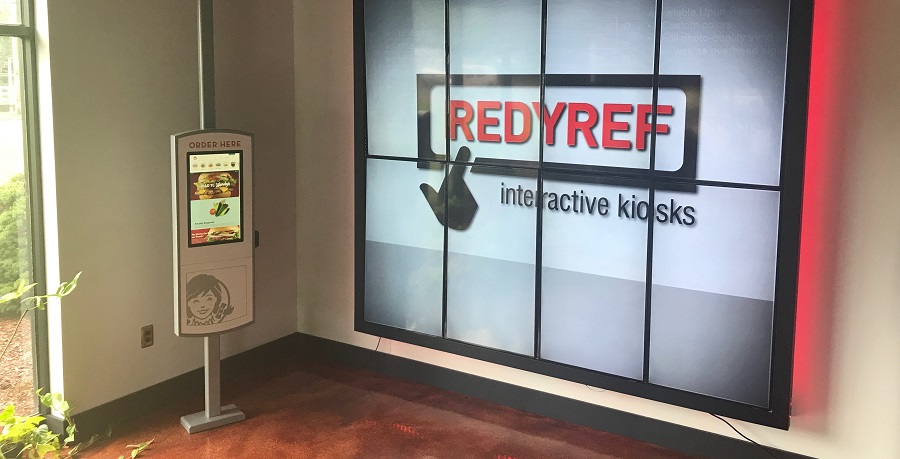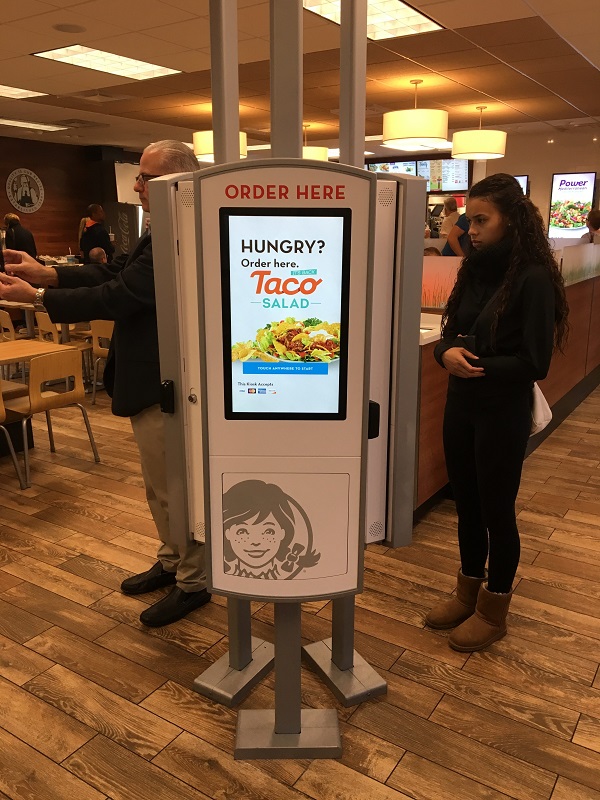The COVID-19 pandemic has drastically impacted restaurants. Because of this, many are turning to various forms of automation, including self-service kiosks, to make their businesses more efficient, require less close contact between employees and customers, and reduce overhead. When thoughtfully deployed, self-service kiosks can also improve the customer experience while making individuals feel more comfortable when dining out. Today we will look at the benefits kiosks can bring to a restaurant and its customers.
What are Restaurant Kiosks?
A restaurant kiosk combines a computer with what is generally a touchscreen display in an enclosure that is customer-facing, allowing them to order without going through an employee to do so. Customers can use the kiosk to send orders directly to the kitchen, allowing in-person staff to handle other roles in the restaurant.

Kiosks can be large, freestanding systems, or as small as an iPad or other tablet computer. Some restaurants locate their ordering kiosks at the front of the house, others at the table, while still others deploy them not far from the traditional order counter. Some quick-service restaurants (QSRs) are even adopting outdoor ordering kiosks for certain locations.
Why are Restaurant Kiosks Important?
Restaurant kiosks allow restaurants to better cater to the needs of their customers and guests. As with many self-service kiosks, restaurant kiosks lower overhead costs for the restaurant and can increase sales via cross-selling and upselling opportunities, all while helping to create a more comfortable environment for the customer, many of whom appreciate the freedom of ordering at their leisure, without the need to wait for a staff member to wait on them. Automating the ordering process means that restaurant staff is then freed up to handle more complex tasks such as catering to specialized customer needs which results in a better experience for them and provides staff with more engaging work.
Examples of Restaurant and Food Court Kiosks
Wendy’s
Wendy’s required a kiosk for their quick-service restaurants that was visually attractive to younger customers while reducing costs at their locations. To suit Wendy’s needs, REDYREF developed an all-purpose kiosk model known as the Presto. This interactive kiosk can be pole or wall-mounted, making it a flexible option for a range of different store footprints. The software was optimized to decrease wait times during peak hours and allow for easy order customization for diners while providing incremental upsell options during ordering. The initial test was a success, prompting Wendy’s to widely adopt self-service kiosks at many of their locations. The kiosks increased sales, reduced costs, and made the QSR more appealing to a younger audience by offering self-service technology.
Subway
Subway needed an interactive kiosk solution to attract a younger customer base, reduce costs, and increase sales. Their solution was to install a drive-through interactive kiosk at many of their locations that would allow their customers to easily order a sandwich without having to walk into the store. The primary advantage of the drive-through kiosk is that it allows customers to order food from the comfort of their own vehicle and have it made quickly, with exceptional accuracy. Many locations are seeing success with these kiosks, prompting Subway to install even more of these drive-thrus in a number of different locations.
Chili’s
To better engage with its customers, Chili’s installed 200 tablet kiosks as a test in restaurants across the chain in 2013. Less than a year later, Chili’s had installed nearly 45,000 tablets -- a testament to table top tablets’ success. The tablets provide many benefits to the restaurant chain as it increases the accuracy of orders, the speed of food delivered to tables, and provides a boost to sales in the form of up- and cross-selling. The tablets are placed at every table, allowing customers to order what they want, when they want it, without the need for waitstaff. The tablets also provide games and other entertainment, helping Chili’s maintain its reputation as a family-friendly dining destination.
Food Court Kiosks
Costco
To increase the efficiency of their food court, Costco has implemented self-service kiosks at all their locations. These kiosks are designed to provide an enhanced customer experience, with customers only needing to utilize a simple touchscreen to order, which then directs them to a specific line where they can quickly pick up their items.
Major League Baseball Stadiums
Major League Baseball stadiums have been utilizing self-service food and beverage kiosks for a number of years to ensure their fans don’t miss an important play. With so many fans filling the stands of sporting events, it’s easy to see how lines for concessions can get long, and these kiosks allow spectators to easily order food and beverages while cutting down wait times. Overall, these kiosks have been considered a success, increasing the size of food orders from 16-25% during the time they’ve been deployed.
Disneyworld Quick Service Restaurants
Disneyworld has begun adopting the quick-service format into many of its restaurants. From deserts to more extensive dine-in locations with larger menus, Disneyworld utilizes self-service kiosks to expedite the food ordering process. With such a large volume of guests daily, these kiosks ensure that guests enjoy a better customer experience, with less time waiting, and therefore, more time to spend enjoying the resort.
Benefits of Restaurant Kiosks
Increased Profitability
One of the great benefits of restaurant kiosks is that it allows businesses to promote their products in a way that is less intrusive to customers. Kiosks will allow restaurants to upsell, cross-sell, display promotions and include appealing photos of menu items while creating a low-pressure environment where customers have more freedom to order what they want.
A study from McDonald’s found that customers ordering via their kiosks tend to spend 30% or more than those ordering through a staff member, which demonstrates just how substantially kiosks can boost sales. Because kiosks don’t forget to upsell or mention promotions, they are more consistently able to add to the average customer’s order ticket.
Better Order Accuracy
Behind the scenes, restaurants can be quite chaotic, and order input errors are a common occurrence, especially during peak times, like lunch or dinner rushes. This is another area in which self-service kiosks can help. Customers send their orders directly to the kitchen, ensuring that an order wasn’t misheard or miskeyed by a staff member. This helps cut down on waste from the need to remake incorrect orders.
Additionally, health preferences such as food allergies can be more easily added to orders through notes, eliminating another potentially stressful issue for the customer. Restaurant kiosks increase the overall accuracy of orders, ensuring a better customer experience.

Enhanced Customer Satisfaction
Restaurant kiosks help ensure a better customer experience which can increase overall customer satisfaction. With customers submitting their own orders, there is a much lower chance that their order will be wrong which enhances the positive feelings customers have toward the restaurant. With guests that order through a tablet, servers can focus on more complex tasks, like improving the guest experience with more attentive, personalized service.
Reduced Labor Costs
Kiosks help reduce strain on overburdened staff, especially during peak times of day. With more menial tasks automated, staff can focus on more engaging aspects of their jobs. With COVID-19, the restaurant industry has been hit hard, and many are operating on skeleton crews out of necessity, to reduce overhead and stay open until the pandemic passes. Restaurant businesses can save on labor costs, while ensuring that customers receive their orders quickly. Servers can then help to provide a better customer experience as well as assist with cleaning or maintenance demands.
Shorter Wait Times
An automated system means shorter wait times. With self-service kiosks available, the system of ordering and receiving food becomes much more convenient. Customers are provided more freedom in their ordering options, reducing both the wait time to place an order with a staff member, as well as receive their food.
Why REDYREF for Self-Service Restaurant Kiosks
Self-service kiosks allow restaurants to serve their customers directly, catering to their needs while increasing revenue and reducing wait times. As kiosk technology evolves, they will continue to improve the customer ordering experience, demonstrating the value they can bring to food service environments from fast casual, to QSRs to commissaries.
REDYREF is a leader in restaurant kiosk development and manufacturing. As one of the most trusted names in the industry, they provide flexible kiosk solutions to fit their customers’ needs. REDYREF manufactures its kiosks with an emphasis on quality and longevity, meaning less required maintenance and a better long-term ROI for customers’ kiosk investments.


